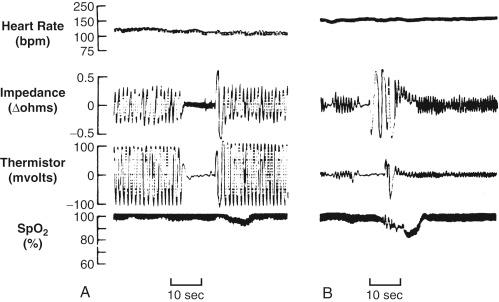Physical Address
304 North Cardinal St.
Dorchester Center, MA 02124
A 2.5-kg, 4-month-old male infant presents for a large, irreducible inguinal hernia repair. His history is significant for premature birth at 26 weeks of gestation, intraventricular hemorrhage, and immature lung disease requiring mechanical ventilation for 3 weeks. He was discharged home at 3 months. Combined spinal epidural (caudal) anesthesia is performed as the sole anesthetic technique for this procedure. After subarachnoid block in sitting position using 1 mg/kg of isobaric bupivacaine injected at the L3–L4 level, the intravenous catheter is inserted in the lower extremity. An epidural catheter is inserted through sacral hiatus (caudal) using ultrasound guidance to confirm the catheter at the L1 level. The pacifier is dipped in sucrose solution, and the infant is allowed to suck on the pacifier during the procedure. At 75 minutes into the procedure, 0.25% bupivacaine 1.5 mg/kg was injected slowly via epidural catheter to maintain the block for the 2-hour surgical procedure. After 3 hours in the neonatal acute care unit, he is noted to have episodes of apnea. Caffeine 20 mg/kg is administered intravenously to prevent further apneic episodes.
The authors wish to thank Dr. Liana Hosu for her contribution to the previous edition of this chapter.
Postoperative apnea is defined by periods of no ventilation during recovery after anesthesia and operation, usually in former premature infants or full-term neonates. This is distinguished from apnea of prematurity and apnea of infancy, which occur in premature and full-term infants, respectively, who have not had anesthesia or surgery.
Postoperative apnea is characterized by duration and type. Cessation of airflow for greater than 15 seconds is diagnostic for apnea. Alternatively, shorter periods of periodic breathing (>6 seconds) are considered to be apnea if associated with bradycardia or hypoxemia. In terms of type, apnea can be central, obstructive, or mixed ( Fig. 202.1 ):
Central apnea occurs without respiratory effort.
Obstructive apnea occurs with respiratory effort, but without ventilation.
Mixed apnea is characterized by absent ventilation with occasional respiratory effort.

The incidence of postoperative apnea depends on detection methods. Studies using continuous recording devices (pneumograms) including flow and chest wall sensors reported rates of 31% to 49% compared with apnea rates of 5% to 10% from studies that relied on nurse observation or bedside cardiorespiratory monitor alarms.
The incidence of postoperative apnea is influenced by patient, surgical, and anesthetic factors. Of these, premature birth history is the most important. Prematurely born infants less than 60 weeks of postconceptual age are at risk for postoperative apnea, although full-term infants less than 4 weeks of postnatal age are also at risk. In formerly premature infants, factors that influence the incidence of postoperative apnea include the following.
Become a Clinical Tree membership for Full access and enjoy Unlimited articles
If you are a member. Log in here